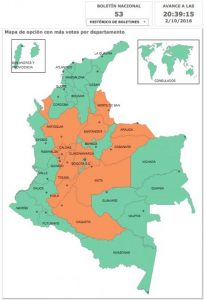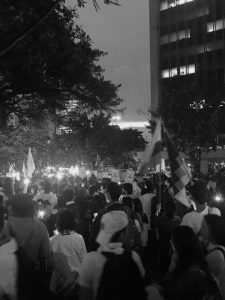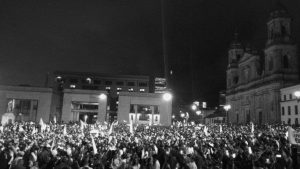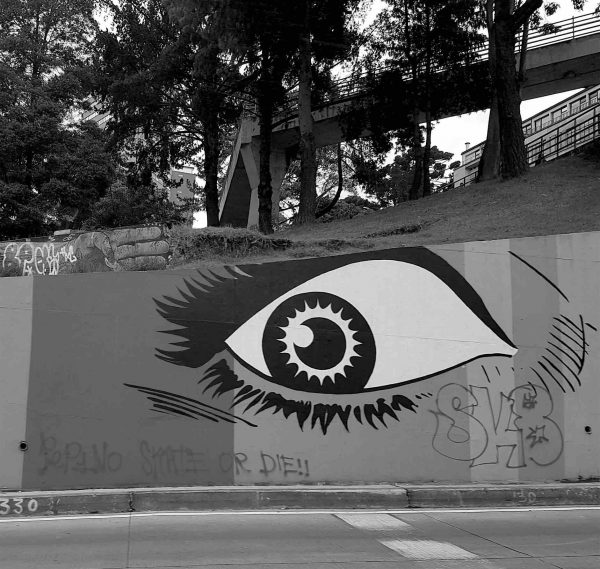This article, authored by Senior Lecturer in International Law Dr Luis Eslava, was originally published on the Critical Legal Thinking blog
Facing the negative results from the plebiscite to ratify the peace agreements, Colombia is in the midst of a counter-revolution of sorts. But the country is not staying still.
The day arrived, voting stations opened in the morning, they closed in the afternoon, and results hastily came through.
Towards the end of the day, and in less than one hour, on Sunday, 2 October 2016, it was confirmed that one small section of the Colombian population, slightly larger than another section, had voted ‘No’ to ending the Colombian conflict through the peace agreements which had been painstakingly negotiated in La Habana over the course of four years (between September 2012 to August 2016).
The margin was minimal, only 53,894 more votes for the ‘No’ than for the ‘Yes’.
Abstention was high, around 62%.
In a country where 34,899,945 people were able to vote, only around 12.8 million casted their decision in the ballot box. The outcome, in electoral terms, however was clear. The ‘No’ wins. The peace agreement cannot be implemented.
Today, the country is paralysed.
The government has extended the ceasefire until 31 of October and has started negotiations with the ‘No’ side.
FARC leaders remain committed to the search for peace but there are rumors that they have asked their troops (around 5,700 women and men) to start preparing a retrieval to safer places.
Colombians are severely polarized around the ‘No’ / ‘Sí’ results.
In the midst of all of this, a counter-revolution is emerging.
Small ‘No’; Big ‘No’
With their vote, the ‘No’ rejected not only the end of hostilities between the Colombian army and FARC (Fuerzas Armadas Revolucionarias de Colombia) on the basis of the agreements. They also rejected a complex document (of almost 300 pages), negotiated with the participation of third countries and supported widely by the ‘international community’ and international institutions, from the Security Council of the United Nations to the World Bank (for whatever that’s worth).
Its length and the time it took to prepare the peace agreements reflect the intricacies of the Colombian conflict, the sheer scale of the stakes involved, and most importantly the deep-rooted nature of the issues under negotiation. It is not just about ending a long conflict. It is, most of all, about trying to address some of the structural elements underpinning this apparently intractable war: land redistribution, political representation, security for new and dissenting voices, transitional justice mechanisms through which to speak truth, to know the truth.
As I mentioned here, Colombia has endured sixty years of civil war. Sixty years in the medium-term past of an entire lifetime. Two centuries in the longer republican past. Five centuries in the extended past of European colonialism.
The country seems to agree – or at least a good proportion of, I would like to think – that the conflict has a colonial origin, and that the cycle of violence and domination set in motion by the Spanish conquest was compounded during Colombia’s half-baked republican history, with its long bipartisan wars, its entrenched poverty, and its aggressive elites. The echoes of the conquest and our tumultuous post-colonial history are materialized, today, in astronomical levels of economic inequality, land concentration, socio-spatial segregation (within cities and across the country), unemployment, internal displacement (the number of internally displaced persons or IDPs in Colombia oscillates between 6 and 8 million), and criminality. The latter is, of course, associated in particular with the production and trade in narcotics – a trade which, as many Colombians also agree, has become the only viable industry in a deindustrialised nation still reeling from at least two-and-a-half decades of structural adjustment and ‘free’ trade ‘discipline’. The tangibility of all of these problems is intense. Reality speaks loud in Colombia (Photo 1.)

So with their no, the ‘No’-side confirmed, willingly or not, that along to their refusal to end the war through the peace agreements, they were also opposing the beginning of a process of land redistribution; opposing transitional mechanisms of justice; opposing truth; opposing new political formations; opposing a space in the Congress for ex-guerrilla fighters; opposing the lowest interest rates ever proposed by the World Bank to the country; opposing the support of the Security Council to the peace process which would have had important repercussions for the discussion of transitional mechanisms at the International Criminal Court; opposing the joint fight against irregular criminal groups; and, most importantly, opposing the banning of violence as a mechanism of political negotiation.
The Visible ‘No’
But the reasons behind the ‘No’ are very diverse. And this is extremely important to keep in mind because there are two rationales in operation here; to levels to this ‘No’: one visible, the other subterraneous. These two levels are dancing a dangerous tango at the moment, on television, computer and mobile phone screens, on Facebook and Twitter accounts, in the rooms of the headquarters of the political parties, and most importantly, on the minds of all Colombians in one way or another.
A viva voce, at the level of open argumentation, it seems that there are three main groups within the ‘No’. (Apologies, of course, for the surgical approach here, but the reader will understand that the situation deserves some kind of mapping).
There is a section of the No-vote that is simply opposed to the idea of welcoming guerrilla fighters into civil life, either because these voters have themselves been the direct victims of the actions of this group, or because they see a total war against FARC as the only way forward. They have something similar to the disastrous war in Sri Lanka against the Tamils in mind. This is the position that in Colombia is known as ‘guerreristas’ – warmongers.
Walking behind this group, there is another section of the ‘No’ that is opposed to the agreements for two reasons. Either they feel that the peace agreements are too lax or too generous with the guerrillas in terms of criminal justice and future political representation (a ‘too much impunity’ kind of argument); or they insist that the agreements, as a whole, beyond their failure to punish the guerrilla fighters properly, lack legitimacy per se. Here the absence of legitimacy is derived from a sense that the negotiations did not include all the necessary stakeholders during the negotiations, or that the final document of the agreement was not properly socialized, not properly explained to the public.
In this group one hears comments along the following lines: ‘the agreements were badly designed’; ‘they seemed to give too much terrain to guerrillas’; ‘we are giving the country to them for free’; ‘we can negotiate something better’; ‘I am afraid of an uncertain future, so I voted ‘No’.’
Finally, there is a third group that voted ‘No’. This group dislikes the manner in which the negotiations were conducted, more at the level of procedure than in terms of their substance. Like the second group, voters of this persuasion feel that the agreements were not managed as they should have been, that the guerrillas were petulant at the start of the negotiations and that they have only become more sensible recently, and that President Santos, frustrated with the difficulties of keeping things in track, ended up manipulating the country by setting a plebiscite to endorse the full agreement only after it had been signed in La Habana. Maybe for them, if Santos had approached the plebiscite in a different way, they would have been compelled to vote ‘Sí’. Importantly, this group, like the second ‘No’ group, side themselves with a negotiated solution to the conflict. They are not warmongers. Instead they see themselves as being on the side of peace – peace in a different way, not the ‘peace agreements’ way.
The Subterraneous ‘No’
However, there is also a set of subterraneous reasons that underpinned the ‘No’ narrative throughout the pre-plebiscite campaign, and which continue to support this position in the wake of the referendum. Gramsci would have placed these reasons in the sphere of common-sense. These reasons are connected with broader structural conditions in Colombia, but they remain largely hidden in everyday rhetorical gestures, never quite fully expressed, and yet surfacing now and then in conversations; lightly peppering policy proposals about what to do next. These subcutaneous reasons make the ‘No’ position of the first group of voters, the guerreristas’, extremely dangerous, or at best extremely problematic in the case of the second and third ‘No’ positions.
Some of these subterraneous reasons became evident immediately after the final result of the plebiscite was announced, when it became clear that the peripheral areas most affected by the conflict, normally rural areas, had voted ‘Sí’, while the urban areas, less affected by the conflict, had voted ‘No’.
This electoral cartography does not mean necessarily (as many international reports have argued) that the rich voted ‘No’ and the poor voted ‘Sí’ – or that the victims of the conflict voted ‘Sí’ and urban citizens and the big and safe land owners and industrialists voted ‘No’. (1)
As I mentioned above and here last week, the conflict in Colombia is old and deeply entrenched in the geography and the social fabric of the country. In this sense, everyone, in one way or another, has been affected by the war.
What the cartography of the plebiscite does show, however, is that populations that have long suffered the direct effects of violence, and which face an imminent threat of future direct violence if the conflict reignites, endorsed the peace agreement. Not surprisingly, these areas are also some of the poorest parts of the country – areas in which extreme concentrations of land ownership is still the norm, and in which the living conditions of people and small producers are appalling. (Photo 2)

This is the case, for example, in Bojayá, a municipality in the department of Chocó, on the Pacific coast. The inhabitants of Bojayá suffered a terrible massacre perpetuated by FARC in May 2002, in which 119 civilians were killed. Regardless of this past, residents of Bojayá supported the peace agreements en masse, as was also the case of the entire Choco, where 96,15% of the population voted ‘Sí’.
The resilience and amazing willingness of the Sí-voters in these sections of the country to bet on a different future, and to forgive one of the main perpetuators of violence in their territories, is astonishing.
At the same time, however, the results from Sunday also show that the main areas and cities in the center of the country have become the refuge of the many, many IDPs created by the war, and places of profound dissatisfaction with the guerrillas and the conflict. As good example of this, we might look at how the different neighbourhoods in Bogotá voted in the plebiscite. As a whole, the city contributed the largest number of ‘Sí’ votes nationally. However, if one breaks down the numbers per area of the city (known as Localidades), some of the poorest parts voted ‘No’ (such as Usme, Bosa and Ciudad Bolívar). A similar thing can be said of those departments that lie close to the border with Venezuela, where the Colombian civil war has been felt profoundly over the last decades, and where the panic of a crisis unleashed by the prospect of a ‘communist revolution’ (here they look across to their neighbours, mired in economic crisis) convinced many that the only option was to say ‘No’. (More about this below.)
So one of the subterraneous reasons for the ‘No’ concerns the large section of the Colombian population that screams out for a ‘strong hand’ (mano dura). These ‘No’ voters are tired of dreaming for a better future. They deeply distrust the present. They want the real. They want army and police presence on the streets and rural areas. They want control. A sense of order. And they want it now.
The Face(s) of the Subterraneous ‘No
The other subterraneous reasons behind the ‘No’ are directly connected with the previous point. It is here that the face of Alvaro Uribe – ex-president between 2002 and 2010 and currently a Senator on behalf of his party, Centro Democrático – must fill our screens.
Uribe represents for many in the country the quintessential figure of a strong man. The one. The now. He makes common sense for many. He speaks common-sense.
A massive land owner, a lover of horses, rich, assertive, conservative in his dress-code, fearless in his attacks to enemies, a power addict, an expert twister of institutions, a skillful deflector of attacks and investigations, a hater of everything ‘communist’, ‘socialist’, Cuban, Venezuelan or the like (his father was killed by FARC in 1983 during a kidnaping attempt), and someone deeply in love with the use of force, Uribe has captured the collective imagination of a huge part of Colombia for nearly fifteen years.
In the context of the peace agreements, Uribe emerged as the natural leader of the ‘No’ campaign. With his assertiveness and using in full all his personality traits he managed to refuse all invitations to take a place around the negotiation table. Indeed, instead of taking part of the process, he made every attempt to derail the conversations.
Today, around Uribe, both guerreristas and voters whose concerned focused on questions of ‘impunity’ coalesced with other subsections of the ‘No’ that, until this week, had remained pretty much off the public radar.
Once the results of the referendum were announced, and as soon as it was clear that he and his supporters had ‘won’, Uribe started to lay out his plan to rewrite the painstakingly drafted peace agreements.
Four points have been put on the table, none of them actually embracing the arguments they used to hammer the ‘Sí’ campaign during the run-up to the plebiscite. Strikingly, arguments concerning the illegitimacy and impunity promoted by the agreements are missing completely from the ‘No’ campaign’s post-referendum proposals (2). Instead, the voice of those other more obscure alliances amongst the ‘No’ have begun to surface.
Firstly, and without mentioning that this was always central to the original peace agreement, Uribe has called for an amnesty for low-level guerrilla fighters. What is different, however, is that Uribe has not specified how such amnesty is to take place. In particular, he has not said whether he wants to condition these amnesties on the telling of the ‘truth’ (something that the original agreements set out clearly). This aspect of Uribe’s proposal has been broadly understood as repeating the basics of the agreement, and thereby confirming silently that he, and the ‘No’ more broadly, didn’t have any actual substantive concern with the possibility of promoting ‘impunity’ through framework set up in La Habana. The media and the public has thus seen this proposal as evidence that Uribe is trying to gain political terrain in order to capture the peace process and rebrand it as his own. So, so far, so not too bad. Really a not big deal.
Secondly, and here is where things start to become a bit knottier, Uribe has announced that it is important to shrink the social component of the peace agreements, especially in terms of the necessary fiscal reform that accompanies the transitional process. This fiscal reform is needed in order to finance the social commitments made in the agreements. According to Uribe, however, fiscal reform will increase taxes for foreign investors, a sector that he has supported unapologetically for many years. He has also insisted that a peace agreement which puts ‘private initiative’ (la iniciativa privada) at risk would destroy any future peace. Neoliberalism strikes back, in other words.
Thirdly, Uribe wants to extend the amnesty rules for guerrilla fighters to members of the official Army. He has (euphemistically) labeled this proposal alivio judicial (‘judicial respite’) for army officers not involved in serious war crimes. This proposal is extremely dangerous. Not only does it blur the line between irregular and official forces; not only does it fail to condition amnesties on the telling of ‘truth’; It also suggests that Uribe is reaching out to dissatisfied members of the Armed Forces, who, up to this point, have sided with the government and with the peace process. Striking back here, that is to say, is brute force in the form of raw sovereign power. The government should decide on the exception, especially if the state is administering the violence. Once again, mano dura – mano dura that could even verge on actual impunity.
Fourthly and finally, Uribe has called attention to dissenting voices (on the Right) as important elements in ‘representatives’ of the civil society who should be brought to post-plebiscite peace negotiations – in particular, ‘religious leaders’ and ‘moral pastors’ (especially Christian national figures) and other visible heads of the ‘No’, including the ex-conservative president Andres Pastrana and the ex-General Inspector Alejandro Ordoñez (who recently lost his position due to irregularities in his second appointment in office).
Ordoñez, famous in the country for burning ‘evil’ books during his undergraduate years, for his radical condemnation of abortion, and for his crusade to protect the ‘values of the family’ (los valores de familia), has been outspoken about the apparent ‘gender ideology’ (la ideología de género) in the agreements. For Ordoñez, as for the ‘religious leaders’ and ‘moral pastors’ identified by Uribe, the mention of the LGTBI population in the agreements is a further mainstreaming of a dangerous ideology that should be prevented at all costs. Hard-fought rights won by the LGTBI movement through official channels at the Colombian Constitutional Court and the legislature, are now being contested as part of the opposition to the peace agreements. Striking back here, then, is mano dura – this time in its most literal masculine, heteronormative form.
Counter-revolution
The act of placing a little distance between the different positions amongst the No-voters reveals that what we have developing right now in Colombia – minute by minute, hour by hour – is a full-scale counter-revolution. A counter-revolution under the aegis of the voting results of 2 October 2016. Visible and subterraneous reasons are merging under the hideous stereotype that we, Colombians, have made of ourselves. Claimers of mano dura.
Sadly, the result is that questions about the apparent ‘illegitimacy’ of the agreements, about the allegedly ‘impunity’ promoted by them, and about their alleged lack of socialization, have been superseded by the unrolling of a post-conflict agenda predicated on an even more restrictive political economy, on more violence, on more prejudice and on fewer rights for minority groups.
As this counter-revolution slowly takes form, the country is noticing how the electoral map, colored green and orange by the ‘democratic’ exercise last Sunday, now speaks of deeply engrained conservative ideas, elite interests, and deep-rooted fears. Like the Brexit referendum in the United Kingdom, the cartography that has emerged in Colombia as a result of the plebiscite tells now a story of hate and exclusion.
In the case of the LGTBI community, this is extremely worrying. Already during the run-up to the plebiscite, memes were circulating on social media about the ‘Sí’ being trapped in an homosexual economy. The picture of Timochenko (Timoleón Jiménez), the FARC’s main commander and one of the most visible figures during the negotiation of the peace agreements in La Habana, having sexual intercourse – in the ‘Sí’ official logo shape – with the Colombian president, Juan Manuel Santos, fed into a widely-circulated argument that in singing up to the peace agreement the country would be giving away its ‘virility’ along with its sovereignty. (Photo 3)

Supporters of the ‘No’, who circulated this image, are now, very sadly, at the forefront of the discussion about the future of the country. Not only can they push, now, for a more mano dura with the FARC. They can also advance their own disdain for the LGTBI community, as if that distain had been articulated directly by the 6.431.376 people that voted ‘No’, and that by the entire country which is now obliged to follow the electoral result. The saddest possible face of democracy is the one that is striking back now.
Revolution in Present Tense
Vijay Prashad has lucidly summarized the current. According to Prashad, ‘[i]f the vote had gone the other way, Colombia might have shown the world that even intractable civil wars can come to an end. It would have been a message to Syria and to the Congo, a message of the power of negotiation towards a new civic compact. But this did not come to pass. Even as President Santos and the FARC leadership try to maintain their optimism of a deal, the return of Mr. Uribe suggests that Colombia might turn its back on a real peace.’ (3)
While facing this reality, and the gloom that it has casted over the country, it is still important to remember that on 2 October, the ‘No’ won by no more than a handful of votes.
As I noted in my last post, the plebiscite was an opportunity for Colombians to insist to themselves, to tell each other, that they were more than their stereotypes. To show themselves that they were conscious of their own history. And my feeling is that this is definitely what happened last Sunday for the ‘Si’ voters. And this is definitively what is still happening for them and for those who slowly are realizing about the limits of the ‘No’.
As I write this, Indigenous communities have just reaffirmed their ‘yes’ to peace and to the peace agreements (4).
Children across the country have said ‘Sí’ (5).
The LGTBI movement has stood up again, and reconfirmed that they are on the side of the peace agreements. They stand ready to argue back against the senseless idea of an ‘ideología de género’ and to challenge the direct questioning of their rights and their place in a contemporary and future Colombia (6).
Students have said yes, and they are marching across Colombia at this very moment demanding ‘peace now’ (7). (Photo 4 and 5)


As the rubble of history continue to hurl itself before our feet, we, Colombians and fellow travelers, must remember that other worlds are possible. History has told us so. We must capture the memories of other times, better times, as they flash before us. These images, as Walter Benjamin warned us, reveal themselves only ‘in a moment of danger’. Our job is to try to summon up the courage to make them real (8),
I must thank Rose Parfitt for all of her comments, wonderful suggestions and generous editorial support. Thanks also to Natalia Angel and Paola Andrea Acosta for letting me use their photos of the Peace March. All limitations of this piece are clearly mine.
Luis Eslava is Senior Lecturer in International Law at the University of Kent.
See the original post on the Critical Legal Thinking blog.
Footnotes:
- El País, ‘Las zonas urbanas y la élite agraria de Colombia impulsaron el triunfo del ‘no’’ (3 October 2016):http://internacional.elpais.com/internacional/2016/10/03/colombia/1475511558_836662.html ↩
- El Tiempo, ‘Las tres primeras propuestas de Uribe para seguir con proceso de paz’ (3 October 2016):http://www.eltiempo.com/politica/proceso-de-paz/propuestas-de-uribe-para-el-proceso-de-paz/16717750; El Espectador, ‘Uribe mantuvo peticiones tras reunión con Santos’:http://www.elespectador.com/noticias/paz/uribe-mantuvo-sus-peticiones-tras-reunion-santos-articulo-658754 ↩
- Vijay Prashad, ‘A lost opportunity’ (The Hindu, 5 October 2016):http://www.thehindu.com/opinion/op-ed/columbia-peace-deal-a-lost-opportunity/article9184857.ece ↩
- El Espectador, ‘Organización Nacional Indígena lamenta triunfo del No en plebiscito’ (3 October 2016):http://www.elespectador.com/noticias/paz/organizacion-nacional-indigena-lamenta-triunfo-del-no-p-articulo-658308 ↩
- El Espectador, ‘En el plebiscito de los niños ganó el Sí’ (2 October 2016):http://colombia2020.elespectador.com/pais/en-el-plebiscito-de-los-ninos-gano-el-si ↩
- Mauricio Albarracín, ‘La maquinaria homofóbica’ (4 October 2016):http://www.elespectador.com/opinion/maquinaria-homofobica ↩
- El Tiempo, ‘Multitudinaria manifestación por la paz llena la plaza de Bolívar’ (5 October 2016): http://www.eltiempo.com/colombia/otras-ciudades/marchas-por-la-paz-en-colombia/16719248 ↩
- Walter Benjamin, ‘On the Concept of History’ (1940):https://www.marxists.org/reference/archive/benjamin/1940/history.htm↩

